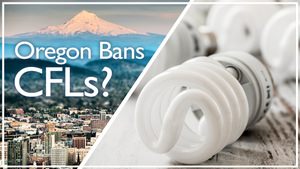Fluorescent tubes have been illuminating the world for over 100 years with phosphorus fluorescence. Find out more about this curious substance here!

Fluorescent tubes have existed since 1901 - but it took over thirty years for professionals to perfect the product and make it appropriate for general commercial use.
Q: Why was this such a touchy product?
A: Good ol' mercury.
When not handled correctly, mercury can be dangerous. Thankfully, we have found a way to utilize this unique substance and use it one of the most prominent methods of industrial illumination - fluorescent lamps!
What are fluorescent lamps made of?
Fluorescent lamps utilize the function of fluorescence through mercury to emit light. Fluorescence is a natural phenomenon in which light is emitted by a substance or living creature that has first absorbed it or, sometimes, radiation. The name, "fluorescence," is derived from the mineral, fluorite, which is known as the most colorful and vivid mineral in the world. (The word psychedelic comes to mind.)
Fluorescent lamps are filled with mercury vapor and coated with phosphor on the inside of the lamp walls. When this mercury is injected with an electrical current, it produces an ultraviolet light that causes the phosphor to illuminate.
How do fluorescent lamps work?

Traditional fluorescent tubes require a ballast to operate, thus making them a more expensive alternative to regular incandescent light bulbs, although more energy efficient.
Fluorescent tubes come in many different shapes and sizes, the most popular of which are T5, T8 and T12. The "T" stands for "thickness", and the number following the T refers to "eighths of an inch", for example: A standard T12 has a thickness (or diameter) of twelve-eighths of an inch, also known as one and a half inches.
Ballasts
Most of the time, one ballast is shared among two or more lamps for efficiency. Older models of ballasts will generally produce a humming noise within the bulb; this can be combated by tar-filled ballast models that reduce noise emission. New models of ballasts rely more on high-frequency operating systems and do not emit any obnoxious buzzing.
LED
Though LED technology was discovered in the mid 20th century, it took until the 2000s for LED tube technology to start appearing, serving as a suitable replacement for traditional fluorescent lamps. LED tubes come in the same models as the fluorescent styles, just with more efficient and cost-effective technology.
How do I recycle fluorescent lamps?
Fluorescent lamps are a common use in everyday applications, the most popular of which are offices, grocery stores, retail stores and warehouses. They can even be found in some home applications. Fluorescent lamps are useful in places in need of a long lasting energy-efficient lights.
Due to the use of mercury in the design of the fluorescent lamp, they are universally regarded as a hazardous waste. The recycling of fluorescent lamps is mandatory per some legal organizations; otherwise, it is a universally recommended form of disposal and any other method of scrapping is highly frowned upon.
Whether your bulb is merely burned out, or it has entirely exploded into pieces in your hand, It is important to follow strict procedures when disposing of fluorescent lamps as to avoid the worst-case-scenario of, well... death.
- If the tube is not broken, turn off all power flowing to the fluorescent fixture, remove the casing and unscrew the bulb. Handle it carefully and transport it to the nearest appropriate recycling center. Unfortunately, because fluorescent tubes are considered a hazardous waste, they cannot be recycled via any standard curbside recycling services.
Once it is in the possession of a recycling service of your choice, large machines are used to break down the glass and extract the mercury from inside the tube, (which can be reused with future tubes.)
- If the tube is broken, it is highly important that all nonessential inhabitants of the room be evacuated immediately, as this can be extremely toxic and dangerous. Find a way to produce airflow, (such as an open window), so that the toxins in the air have a way to escape the premises.
Efficiently clean all remnants of the glass and sweep the powder into a sealable container, such as a Ziploc bag. Store the remains in a safe, isolated area until you are able to contact a recycling service if mandated. If recycling is not a mandate, you are free to dispose through your household garbage. It is always a good idea to take all safety succeeding precautions, such as washing hands and continuing to air out the room in which the accident took place.
The procedures listed can apply to regular CFL breakage/disposal as well.

Fluorescent tubes are so commonly used that both their fascinating operating system and hazardous capabilities are often overlooked. Hopefully this blog was able to shed some more light on this fascinating illuminant, and why it's important to stay safe when handling fluorescent tubes!






